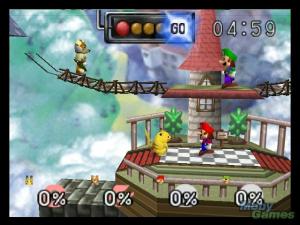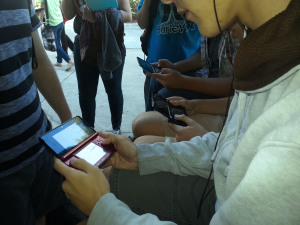Your donation will support the student journalists of Hagerty High School. We are an ad-free publication, and your contribution helps us publish six issues of the BluePrint and cover our annual website hosting costs. Thank you so much!
Smashing!
How Super Smash Bros. breaks the mold of conventional gaming
A smashing history
If there has ever been a desire to see Pikachu from Pokémon being flattened by a hammer-toting Yoshi from the Mario games, consider that desire satisfied with the Nintendo game Super Smash Bros.
Originally released in 1999 for the aging Nintendo 64, Super Smash Bros. was a peculiar game aimed at a peculiar audience. Introducing itself as a juxtaposition of two genres: party games and fighting games, Super Smash Bros. incorporated multiplayer mechanics and genre standards that had never crossed paths before.

“[Smash Brothers] was a way to turn a fighter into something a lot easier to learn. It was more accessible and easy to pick up and play with your friends,” longtime fan of the franchise, senior Macks Massengill, said.
Super Smash Bros. mixes mascots, characters and locales from famous (and even infamous) Nintendo titles into one package. Players select a character from a vast roster and duke it out in a timed, strategic battle with up to four other players. Arenas where the battles are held are all themed heavily to represent major franchises in Nintendo’s first party repertoire.
“I remember that [Smash Brothers Melee] was so… overwhelming because I had never seen anything like it before,” senior Aaron Schaffer said. “I didn’t think that stuff like that could be possible in a game.”
A smashing sequel
September 2014 saw the Japanese release of the newest iteration in the Smash Brothers series, Super Smash Bros. 3DS (or as it is commonly referred to online, SSB4). With playable characters leaked weeks before, features announced by Nintendo at an almost weekly pace and a desperate audience lusting for the game’s release, Super Smash Bros. 3DS was welcomed by a vastly different audience than past games in the series.
When characters and stages were released online in the form of anonymous announcements, fans either shielded their eyes or asked if the leakers had more information for them.
“I just want to play the game like I did when I was a kid. With all the surprise characters and new challengers – not seeing the entire roster online,” senior Tyler Trombley said.

Trombley is not alone in wanting to go into Super Smash Bros. 3DS blind. Large efforts were made in online communities, such as Nintendo’s very own social network, Miiverse, to combat “spoilers” before the game had been released. However, other fans of the series sucked up leaks and official announcements like a sponge.
“I saw news all the time about ‘character X’ confirmed, and ‘mode Y’ being playable in SSB4,” Massengill said.
The desire for the game intensified when a demo was released on the eShop, Nintendo’s digital download service. Those who had been loyal to the Club Nintendo perks program were sent exclusive codes for the demo before it came out for everyone else. Recipients were also sent four additional codes to encourage local multiplayer features before the release.
What began as a gift from Nintendo soon turned into chaos on the web as gamers began gifting, trading, and even selling their spare or unwanted codes. Some codes were sold online for half the price of the full retail game.
Releasing in North America on Oct. 3, Super Smash Bros. 3DS was met with wild critical and commercial acclaim. Only one week after the American release, Nintendo’s PR division announced that the game had already sold 2.8 million copies worldwide, a number that Nintendo claims to be one of the Nintendo 3DS’s best-selling games of all time.
Students have celebrated the release of the game by bringing their 3DS systems to school in order to engage in multiplayer battles. Junior Austin Hayes has brought his 3DS XL to school with him every day since the game came out. “Playing with other people is obviously more fun than playing against the computers. […] You get to see different playing styles and characters, since everyone plays their own way,” Hayes said.
“Playing your own way” is a strong emphasis in the Super Smash Bros. franchise. Especially in the newest game, new game modes, customization options and features have been added in order to encourage players to develop their own play styles. One new feature allows players to customize pre-existing characters and even create their own to bring into battle.
“It’s really fun that you have the option to enable your custom characters, since you can play as your own character, and fight against everyone else’s character as well,” Hayes said.
Portability also has a huge impact on the newest Super Smash Bros. game. Being able to take the game on the go has become a major selling point that both Nintendo, and their fans, are excited about. “[Having the game digitally] is good because I have a 3DS, and wouldn’t have to constantly switch cartridges,” Trombley said. “I would always have it with me.”
A Smashing Community
Multiplayer in Super Smash Bros. 3DS relies greatly on the system’s portability, introducing modes that are enjoyed exclusively through local, 3DS-to-3DS, connections only. Online play is also available, but can be a mixed bag for some players looking to join the Smash Brothers community; especially if they seldom dabbled in online before.

Seniors Kevin Anderson, Aaron Schaffer, and Chris Negron play a quick round of Smash Bros. 3DS during break.
“Online is going to be more of a balance of people who have never played Smash Bros. before and then the people who have been playing forever, and play competitively,” Schaffer said. “It will be weird if you are in that in-between zone.”
Nintendo-moderated communities have been around since 2008’s Wii sequel, Super Smash Bros. Brawl, introduced online play. However, it wasn’t until the fan modification of Brawl called Project M that the online community flourished.
“Because [Project M] is made by the community, it kind of goes to show that there is that competitive audience out there willing to mod the game in order for them to like it,” Massengill said.
When Brawl was met with many complaints and poor sales after release, Project M introduced features and characters to the game that were not included in the official Nintendo version. Characters from the GameCube release, Super Smash Bros. Melee, that were not included in Brawl were added back with Project M. The entire fighting system and physics of Brawl was also overhauled to reflect Melee’s fan-preferred mechanics. The Project M team took everything fans did not like about Brawl and fixed it on their own.
“Nothing had been that huge before, with the community eventually liking [Project M] more than the original Brawl itself,” Shaffer said.
Everyone can Smash
While the Entertainment Software Ratings Board rates Super Smash Bros. “E” for “everyone,” some people still consider the franchise exclusive to children.
“Even if it is targeted at kids, Nintendo’s marketing skills target the game at old fans of the series too,” Trombley said.
With characters that span Nintendo’s history, new players might have a difficult time knowing who they are playing as, unless they are old enough to remember the character’s original debut. Older players, however, are typically more excited to see classic characters announced for the Super Smash Bros. franchise.
That being said, Super Smash Bros. intentionally breaks the assumption that video games are just for kids. With its unconventional mix of genres, dedicated communities and an excited new fan base, the Super Smash Bros. games ignore everything “childish” about video games, and instead invent a new category all of their own.
Super Smash Bros. 3DS released Oct. 3. The console companion, Super Smash Bros. Wii U is set to release Nov. 21.

